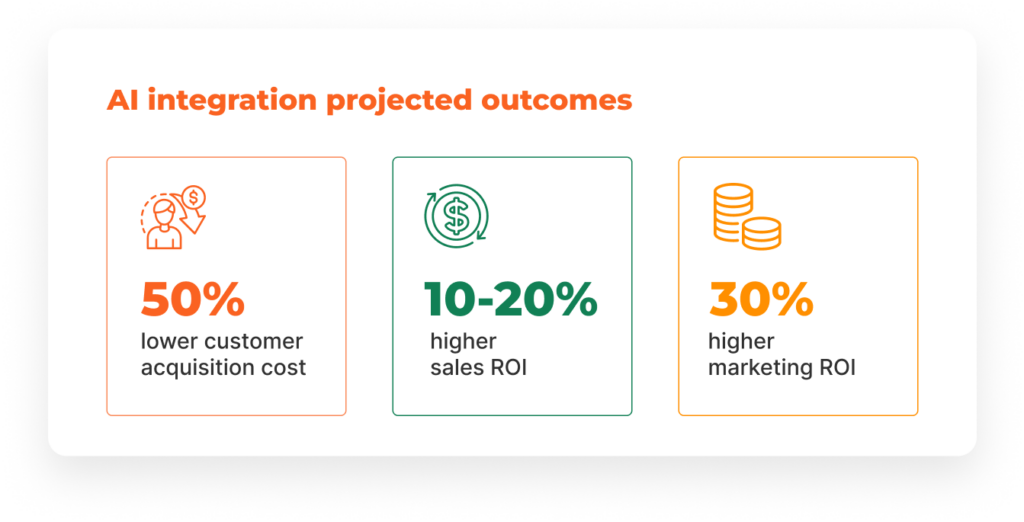Artificial intelligence has transformed how businesses go about automation and efficiency. With everything happening in the Generative AI space lately, technology leaders are also discovering new opportunities to improve customer-facing experiences. At the core of these opportunities is personalization.
As the industry comes up with new AI-driven ways to craft more personal and tailored digital experiences, CTOs are also facing an increased responsibility to keep engineering in sync with design. Bridging the gap between the two is the only way to create software that’s both technologically robust and attuned to user needs. This article will explore strategies that successful tech leaders follow while creating compelling and impactful AI-driven personalization experiences.
AgileEngine offers top-1% software talent with 2X the cost efficiency of traditional hiring. Let’s explore the best way to scale your team
How AI is impacting personalization
Personalization is a key differentiator in customer experience, with returns reaching $20 for every $1 invested, according to research by Liveclicker. This 20:1 ROI potential makes AI-driven personalization a prime area where CTOs can deliver substantial business impact.
Industry leaders have recognized this potential, and giants like Netflix, Amazon, and Sephora are seeing impressive outcomes when integrating artificial intelligence into personalization solutions:
- Netflix’s content curations reportedly help it save over $1 billion annually by reducing customer churn, increasing lifetime value, and enhancing loyalty. Similar recommendation models are widely adapted across industries to improve customer retention and revenue.
- Amazon’s product recommendation engines drive 35% of the company’s sales by precisely tailoring product recommendations to e-shoppers’ needs and interests. While boosting product discovery and creating new revenue streams, this approach fosters repeat purchases while helping cultivate customer loyalty.
- Sephora’s “Personalized Beauty Experiences” combine AI-driven facial recognition with augmented reality to deliver personalized recommendations based on skin type. Enriched by AI analytics of browsing and purchase history, this solution contributes to a projected 5–15% revenue increase and an 18.5% year-over-year increase in e-store visits.
- eMed, a leading UK telehealth company, leverages sophisticated predictive and generative AI models to deliver deeply personalized recommendations based on the users’ diverse health data. The smart approach to AI-driven personalization has made the company a top choice for 80% of individuals seeking weight loss support.
At AgileEngine, we have extensive experience leveraging AI for UX solutions, such as personalization and ChatGPT-based copilot systems, for industries such as video streaming, media, job search, healthcare, and more. Our results demonstrate that integrating AI into recommendation systems can reduce customer acquisition costs by up to 50%, boost marketing ROI by 30%, and increase sales ROI by 10–20%, which aligns with industry projections.

Taking things up a notch with GenAI and Lean UX
Generative AI empowers organizations to deliver deeper levels of personalization by dynamically crafting personalized content, such as targeted messaging, images, and interactive experiences. With advanced AI tools like Vertex AI or Amazon Bedrock, companies can craft precise recommendations and sophisticated search functionalities, providing seamless, tailored experiences that respond to individual preferences in real time.
On the design side, research-driven methodologies enable companies to pinpoint high-impact areas for AI-based personalization. Among various approaches, we’ve found that Lean UX excels at providing tech-focused teams with a clear product strategy reflecting both the user needs and the market landscape. When following Lean UX, stakeholder and user interviews, market research, and system audits are central to decision-making and prioritization.
By combining human-centric design, agile ways of working, and a strong business sense, Lean UX also streamlines the collaboration between designers, product managers, and developers, helping companies reduce rework and cut development costs by 15–50%.
The CTO’s role in championing AI-driven UX
To guide their organizations toward AI solutions that meaningfully enhance customer experiences, CTOs must ensure technical excellence and strategic alignment with UX goals while promoting collaboration between engineering and design teams. Here are some key strategies:
- Promote a culture of user-centric innovation: Encourage teams to prioritize customer insight, adopting research-driven frameworks like Lean UX, which help develop AI solutions that better meet customer needs and boost engagement.
- Invest in scalable and customizable AI tools: Choose adaptable AI solutions that can be tailored to different user needs and touchpoints. Frameworks from cloud AI leaders like Google, Microsoft, and Amazon enable experimentation and innovation at scale.
- Data governance and ethical AI: As AI personalization relies heavily on user data, CTOs must champion ethical data practices and transparent governance, ensuring trust in data usage policies and personalization algorithms to earn the customers’ confidence and loyalty.
- Measure, iterate, and optimize: Ensure regular audits and assessments of AI-driven solutions to help pinpoint areas for improvement, ensuring that AI applications remain effective and aligned with customer expectations.
Summing it all up
In the era of AI-driven personalization, CTOs play an instrumental role in shaping the UX of their companies’ digital products and services. By leveraging advanced AI solutions and promoting a research-driven design process, CTOs can create customer journeys that are meaningful, relevant, and impactful. Investing in AI-powered UX can also help technology leaders position their organizations as innovators in the UX space.













